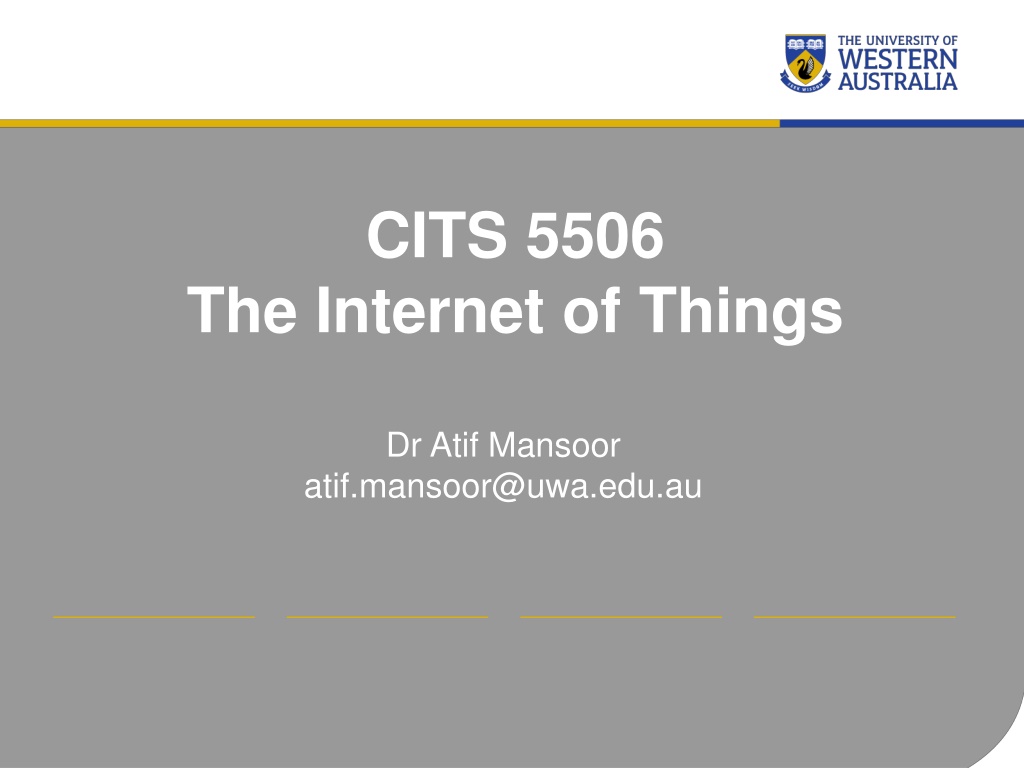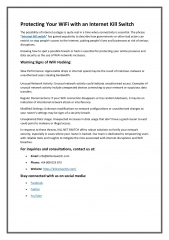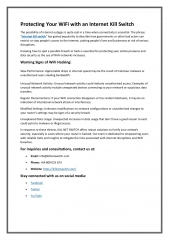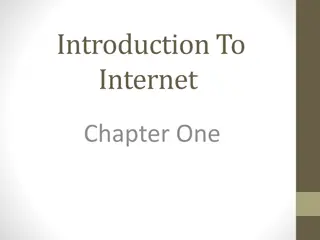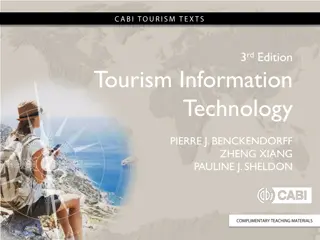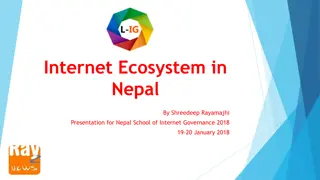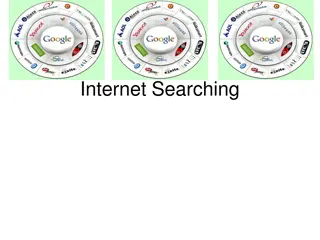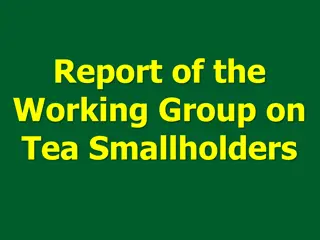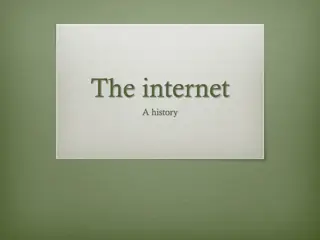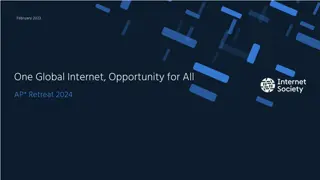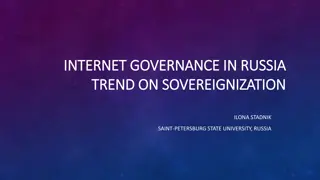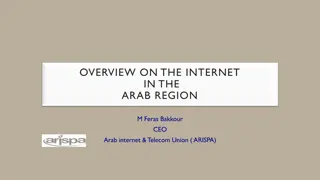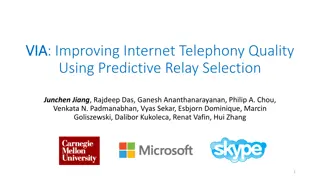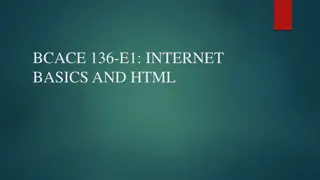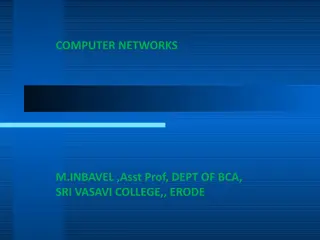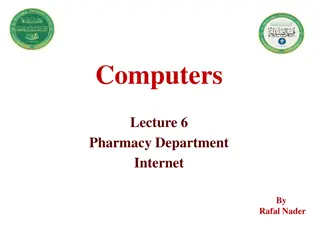Exploring the Realm of Internet of Things in CITS 5506
Dive into the comprehensive course CITS 5506, led by Dr. Atif Mansoor, delving into the vast landscape of the Internet of Things (IoT). The course covers practical components with Raspberry Pi and Arduino boards, theoretical discussions on research papers, paper discussions, essay assignments, and team projects. Grading includes quizzes, class participation, written essays, and project presentations. Embrace the IoT era with a focus on connectivity, data exchange, and minimal human intervention.
Download Presentation

Please find below an Image/Link to download the presentation.
The content on the website is provided AS IS for your information and personal use only. It may not be sold, licensed, or shared on other websites without obtaining consent from the author. Download presentation by click this link. If you encounter any issues during the download, it is possible that the publisher has removed the file from their server.
E N D
Presentation Transcript
CITS 5506 The Internet of Things Dr Atif Mansoor atif.mansoor@uwa.edu.au
Introduction 2 CITS 5506 The Internet of Things
Course Details Practical Component Raspberry Pie Arduino board Theoretical Component Discussion on Research Papers Concise Summary or salient points (written/typed on paper) Project Proposal 3 CITS 5506 The Internet of Things
Paper Discussion What is it? List key insights (e.g. claim, approach, evaluation, problem, solution, your comments) Preferred Style: o Use a word processor o 1 or 2 pages 4 CITS 5506 The Internet of Things
Grading Two Quizzes, providing 10% each = 20% Class Participation (Papers Discussion) = 10% Written Essay, providing (15 % IEEE style essay + 10% Presentation) (individual work) = 25% Team Project = 45% 25% for the Business case/Proposal, 15-20min presentation to class 20% for the Prototype, 15 min presentation/demonstration to class 5 CITS 5506 The Internet of Things
Essay Individual Decide the topic early Short 4 page write-up (IEEE conference format) Due last class before midterm Follow guidelines (will be discussed in class) Essay Presentations 04 October, 2017 6 CITS 5506 The Internet of Things
Introduction to the IoT 7 CITS 5506 The Internet of Things
In your opinion, what is Internet of Things ? In your opinion, What is the Significance of IoT and what are related prospects for you? 8 CITS 5506 The Internet of Things
How IoT works : A Video 9 CITS 5506 The Internet of Things
The Internet of Things *The term Internet of Things generally refers to scenarios where network connectivity and computing capability extends to objects, sensors and everyday items not normally considered computers, allowing these devices to generate, exchange and consume data with minimal human intervention. There is, however, no single, universal definition. * An Overview : Understanding the Issues and Challenges of a More Connected World, Whitepaper, 2015 by The Internet Society. 10 CITS 5506 The Internet of Things
The Internet of Things The Internet of Things is an emerging topic of technical, social, and economic significance. Consumer products, durable goods, cars and trucks, industrial and utility components, sensors, and other everyday objects are being combined with Internet connectivity and powerful data analytic capabilities that promise to transform the way we work, live, and play. 11 CITS 5506 The Internet of Things
The Internet of Things Projections for the impact of IoT on the Internet and economy are impressive, with some anticipating as many as 100 billion connected IoT devices by 20251 Estimated global economic impact of more than $11 trillion by 20251. 1. The Internet of Things : An Overview , Understanding the Issues and Challenges of a More Connected World Published by the Internet Society 12 CITS 5506 The Internet of Things
HAPPY FORECAST 13 CITS 5506 The Internet of Things
What is your opinion ? 14 CITS 5506 The Internet of Things
Challenges for IoT However, the Internet of Things raises significant challenges that could stand in the way of realizing its potential benefits. Societal Challenges privacy fears surveillance concerns, Security Concern (hacking of Internet-connected devices) 15 CITS 5506 The Internet of Things
Challenges for IoT Technical challenges Sensors Power Consumption Security and Privacy Data Analytics Communication Technologies Interoperability / Standards Development Challenges/ Enabling Technologies 16 CITS 5506 The Internet of Things
Challenges for IoT Enabling Technologies: The concept of combining computers, sensors, and networks to monitor and control devices has existed for decades. The recent confluence of several technology market trends, however, is bringing the Internet of Things closer to widespread reality. These include Ubiquitous Connectivity, Widespread Adoption of IP-based Networking, Computing Economics, Miniaturization, Advances in Data Analytics, and the Rise of Cloud Computing 17 CITS 5506 The Internet of Things
Challenges for IoT Legal Challenges The use of IoT devices raises many new regulatory and legal questions: Issues related to cross border data flows Your opinion ? Data collected by IoT devices is sometimes susceptible to misuse, potentially causing discriminatory outcomes for some users. 18 CITS 5506 The Internet of Things
Challenges for IoT Legal Challenges Conflict between law enforcement surveillance and civil rights Data retention and destruction policies Legal liability for unintended uses Security breaches or privacy lapses 19 CITS 5506 The Internet of Things
It may force a shift in thinking about the implications and issues in Potential realization of IoT Moving from Global Village to Hyperconnected world a world where the most common interaction with the Internet comes from passive engagement with connected objects rather than active engagement with content. 20 CITS 5506 The Internet of Things
Emerging Economy and Development Issues The Internet of Things holds significant promise for delivering social and economic benefits to emerging and developing economies. This includes areas such as sustainable agriculture, water quality and use, healthcare, industrialization, and environmental management, among others 21 CITS 5506 The Internet of Things
Emerging Economy and Development Issues The unique needs and challenges of implementation in less-developed regions will need to be addressed, including : infrastructure readiness market and investment incentives technical skill requirements, and policy resources 22 CITS 5506 The Internet of Things
IoT Forecast A number of companies and research organizations have offered a wide range of projections about the potential impact of IoT on the Internet and the economy during the next five to ten years. Cisco, for example, projects more than 24 billion Internet connected objects by 20191 Morgan Stanley, however, projects 75 billion networked devices by 20202 1. Cloud and Mobile Network Traffic Forecast - Visual Networking Index (VNI). Cisco, 2015. http://cisco.com/c/en/us/solutions/serviceprovider/visual-networking-index-vni/index.html 2. Danova, Tony. Morgan Stanley: 75 Billion Devices Will Be Connected To The Internet Of Things By 2020. Business Insider, October 2, 2013. http://www.businessinsider.com/75-billion-devices-will-be-connected-to-the-internet-by-2020-2013-10 23 CITS 5506 The Internet of Things
IoT Forecast Huawei forecasts 100 billion IoT connections by 20253 McKinsey Global Institute suggests that the financial impact of IoT on the global economy may be as much as $3.9 to $11.1 trillion by 20254 While the variability in predictions makes any specific number questionable, collectively they paint a picture of significant growth and influence. 3. "Global Connectivity Index." Huawei Technologies Co., Ltd., 2015. Web. 6 Sept. 2015. http://www.huawei.com/minisite/gci/en/index.html 4 . Manyika, James, Michael Chui, Peter Bisson, Jonathan Woetzel, Richard Dobbs, Jacques Bughin, and Dan Aharon. The Internet of Things: Mapping the Value Beyond the Hype. McKinsey Global Institute, June 2015. 24 CITS 5506 The Internet of Things
IoT Conflicting Perceptions IoT a revolutionary fully interconnected smart world of progress, efficiency, and opportunity, with the potential for adding billions in value to industry and the global economy. Others warn that the IoT represents a darker world of surveillance, privacy and security violations, and consumer lock in. 25 CITS 5506 The Internet of Things
IoT History The term Internet of Things (IoT) was first used in 1999 by British technology pioneer Kevin Ashton to describe a system in which objects in the physical world could be connected to the Internet by sensors. Ashton was working on RFID (radio-frequency identification) devices, and the close association of RFID and other sensor networks with the development of the IoT concept is reflected in the name of the RFID device company that Ashton joined later in his career: ThingMagic. http://www.thingmagic.com/ 26 CITS 5506 The Internet of Things
IoT History In late 1970s, systems for remotely monitoring meters on the electrical grid via telephone lines were already in commercial use1. In the 1990s, advances in wireless technology allowed machine to machine (M2M) enterprise and industrial solutions for equipment monitoring and operation to become widespread. Many of these early M2M solutions, however, were based on closed purpose built networks and proprietary or industry specific standards, rather than on Internet Protocol (IP) based networks and Internet standards2. 1. Machine to Machine. Wikipedia, https://en.wikipedia.org/wiki/Machine_to_machine 2. Polsonetti, Chantal. Know the Difference Between IoT and M2M. Automation World, July 15, 2014. http://www.automationworld.com/cloud- computing/know-difference-between-iot-and-m2m 27 CITS 5506 The Internet of Things
IoT History The first Internet device an IP enabled toaster that could be turned on and off over the Internet was featured at an Internet conference in 19901. Over the next several years, other things were IP enabled, including a soda machine2 at Carnegie Mellon University in the US and a coffee pot3 in the Trojan Room at the University of Cambridge in the UK (which remained Internet connected until 2001) 1. "The Internet Toaster." Living Internet, 7 Jan. 2000. Web. 06 Sept. 2015. http://www.livinginternet.com/i/ia_myths_toast.htm 2. "The "Only" Coke Machine on the Internet." Carnegie Mellon University Computer Science Department, n.d. Web. 06 Sept. 2015. https://www.cs.cmu.edu/~coke/history_long.txt 18 3. Stafford-Fraser, Quentin. "The Trojan Room Coffee Pot." N.p., May 1995. Web. 06 Sept. 2015. http://www.cl.cam.ac.uk/coffee/qsf/coffee.html 28 CITS 5506 The Internet of Things
IoT Evolution From a broad perspective, the confluence of several technology and market trends is making it possible to interconnect more and smaller devices cheaply and easily: Ubiquitous Connectivity Low cost, high speed, pervasive network connectivity, Widespread adoption of IP based networking IP has become the dominant global standard for networking, 29 CITS 5506 The Internet of Things
IoT Evolution Computing Economics Greater computing power at lower price and lower power consumption Miniaturization Manufacturing advances allow cutting-edge computing and communications technology to be incorporated into very small objects & small and inexpensive sensor devices Advances in Data Analytics New algorithms and rapid increases in computing power, data storage, and cloud services enable the analysis of vast quantities of data 30 CITS 5506 The Internet of Things
IoT Evolution Rise of Cloud Computing Cloud computing, which leverages remote, networked computing resources to process, manage, and store data, allows small and distributed devices to interact with powerful back-end analytic and control capabilities. 31 CITS 5506 The Internet of Things
Settings for IoT Applications Setting Description Examples Human Devices attached or inside the human body Devices (wearables and ingestibles) to monitor and maintain human health and wellness; disease management, increased fitness, higher productivity Home Buildings where people live Home Controllers and Security Systems Stores, banks, restaurants, arenas anywhere consumers consider and buy; self-checkout, in-store offers, inventory optimization Retail Environments Spaces where consumers engage in commerce 32 CITS 5506 The Internet of Things
Settings for IoT Applications Setting Description Examples Factories Standardized production environments Places with repetitive work routines, including hospitals and farms; operating efficiencies, optimizing equipment use and inventory Mining, oil and gas, construction; operating efficiencies, predictive maintenance, health and safet Vehicles including cars, trucks, ships, aircraft, and trains; condition-based maintenance, usage-based design, Worksites Custom production environments Vehicles Systems inside moving vehicles 33 CITS 5506 The Internet of Things
Settings for IoT Applications Setting Description Examples Cities Urban Environment Public spaces and infrastructure in urban settings; adaptive traffic control, smart meters, environmental monitoring, resource management Energy management and security in office buildings; improved productivity, including for mobile employees Offices Spaces where knowledge workers work Manyika, James, Michael Chui, Peter Bisson, Jonathan Woetzel, Richard Dobbs, Jacques Bughin, and Dan Aharon. The Internet of Things: Mapping the Value Beyond the Hype. McKinsey Global Institute, June 2015. p.3. http://www.mckinsey.com/insights/business_technology/the_internet_of_things_the_value_of_digitizing_the_physical_world 25 34 CITS 5506 The Internet of Things
Sensor Devices are widely available 35 CITS 5506 The Internet of Things
Sensor Devices are widely available - Programmable devices - Off-the-shelf gadgets/tools 36
How are the Network changing Extensions More nodes, more connections, IPv6, Any TIME, Any PLACE+ Any THING M2M, IoT Billions of interconnected devices, Everybody connected. Expansions Broadband Enhancements Smart networks Data-centric and content-oriented networking Context-aware (autonomous) systems 37 CITS 5506 The Internet of Things
Future Networks 38 CITS 5506 The Internet of Things
IoT Evolution 39 CITS 5506 The Internet of Things
